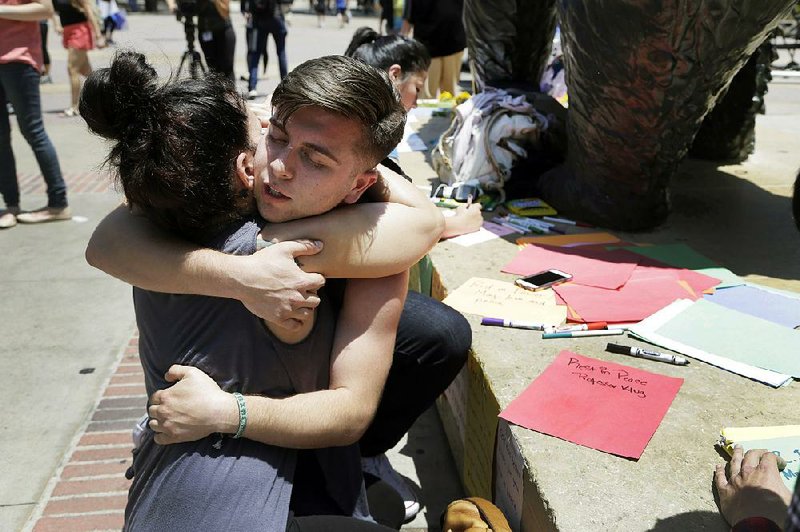LOS ANGELES -- Police investigating a murder-suicide on the University of California, Los Angeles campus announced Thursday that they suspect the shooter earlier killed a woman in Minnesota then drove to Los Angeles to confront a professor he believed had stolen his work.
Detectives also believe Mainak Sarkar, the 38-year-old former engineering graduate student, intended to kill a second professor Wednesday morning, but he could not find him on campus, Los Angeles Police Chief Charlie Beck said.
In a search of Sarkar's home in St. Paul, Minn., authorities found a "kill list" with at least three names that included professor Bill Klug, the woman found dead in a Minneapolis suburb and a second professor who was not harmed, Beck said.
Sarkar shot and killed Klug in a campus engineering building, leading to a lockdown on the campus with 60,000 or more students and staff members. He then fatally shot himself.
Sarkar drove to Los Angeles from Minnesota with two guns and ammunition before he killed Klug.
He left a note at the scene of the Los Angeles killing that asked anyone who found it to check on a cat at his residence in Minnesota, Beck told reporters. It was there authorities found the "kill list," which led them to a home in a nearby town, where they found the woman shot dead.
She was not identified and authorities didn't release how Sarkar knew her.
Beck said Sarkar's dispute with Klug was tied to Sarkar thinking the professor released intellectual property that harmed Sarkar.
A blog post written in March by someone identifying himself as Sarkar said he had personal differences with Klug.
"He cleverly stole all my code and gave it [to] another student," the post said. "He made me really sick."
The blog continues: "Your enemy is your enemy. But your friend can do a lot more harm. Be careful about whom you trust. Stay away from this sick guy."
Beck said the university asserts it was all in Sarkar's imagination.
Sarkar is listed on a university website as a member of a computational biomechanics research group run by Klug, a professor of mechanical engineering.
Police were working Thursday to find the car Sarkar drove to Los Angeles and sought the public's help.
Classes at the University of California, Los Angeles campus resumed Thursday for most of the school, except for the engineering department, where students and faculty members will return Monday.
Klug's colleagues and friends described him as a kind, devoted family man and teacher who didn't appear to have conflicts with anyone.
"Bill was an absolutely wonderful man, just the nicest guy you would ever want to meet," said a collaborator, professor Alan Garfinkel. The two worked together to build a computer model of the heart, a "50 million variable 'virtual heart' that could be used to test drugs."
Initial reports from the scene set off widespread fear of an attempted mass shooting on campus, bringing a response of hundreds of heavily armed officers. Groups of them stormed into buildings that were locked down and cleared hallways as police helicopters hovered overhead.
Advised by university text alerts to turn off lights and lock doors where they were, many students let friends and family know they were safe in social media posts. Some described frantic evacuation scenes, while others wrote that their doors weren't locking and posted photos of photocopiers and foosball tables they used as barricades.
Those locked down inside classrooms described a nervous calm. Some said they had to rig the doors closed with whatever was at hand.
Umar Rehman, 21, was in a math sciences classroom adjacent to Engineering IV, the building where the shooting took place. The buildings are connected by walkway bridges near the center of the 419-acre campus.
"We kept our eye on the door. We knew that somebody eventually could come," he said, acknowledging his terror.
The door would not lock and those in the room devised a plan to hold it closed using a belt and crowbar, and demand ID from anyone who tried to get in.
Scott Waugh, an executive vice chancellor and provost, said the university would look into concerns about doors that would not lock.
One student who spent hours sheltering in a building did the same thing almost exactly two years ago when he was locked down in a dorm at the system's Santa Barbara campus during a shooting rampage in the surrounding neighborhood that left six students dead and 13 people wounded.
Jeremy Peschard, 21, said it was "eerily similar" but that having been through the feeling of crisis before left him almost numb.
"I just felt a little bit less shocked, a little bit less taken aback by the reality of an active shooter on a college campus," he said in an email. "Because I feel like this is the day and age we're living in, that college campus shootings have genuinely become a normalized threat, almost like a natural disaster, except this type of destruction isn't natural. It's just really sad."
Information for this article was contributed by Christopher Weber, Robert Jablon, Justin Pritchard, John Antczak, Alina Hartounian and Amy Taxin of The Associated Press.
A Section on 06/03/2016
